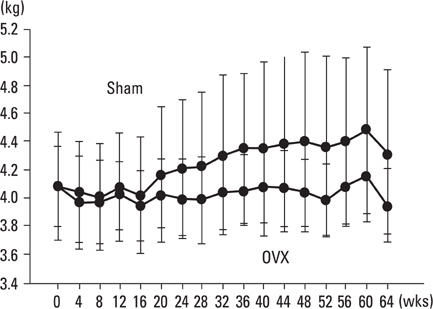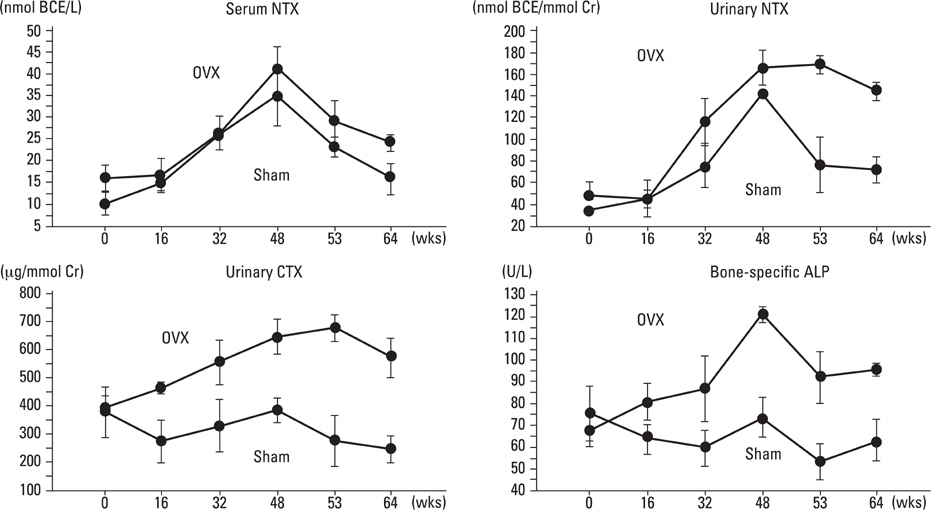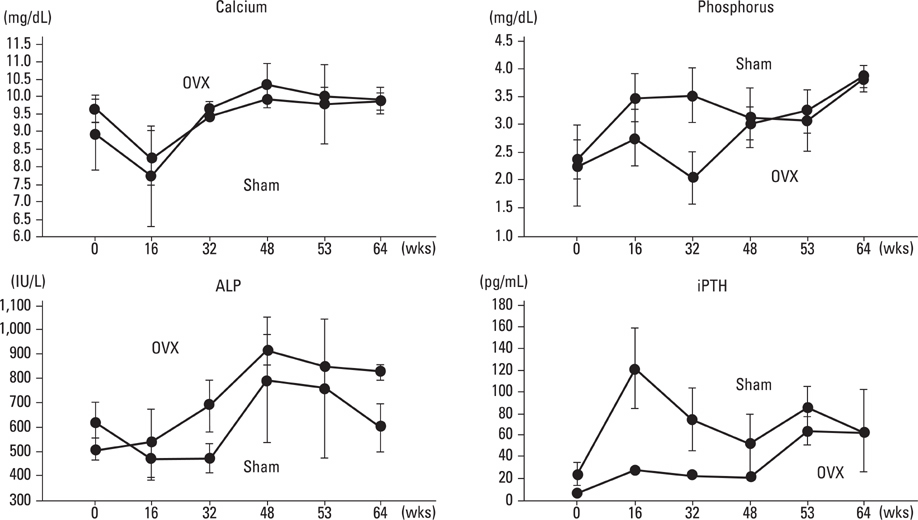Yonsei Med J.
2009 Jun;50(3):358-367. 10.3349/ymj.2009.50.3.358.
Influence of Ovariectomy on Bone Turnover and Trabecular Bone Mass in Mature Cynomolgus Monkeys
- Affiliations
-
- 1Institute for Integrated Sports Medicine, Keio University School of Medicine, Tokyo, Japan. jiwamoto@sc.itc.keio.ac.jp
- 2Hamri Co., Ltd., Tokyo, Japan.
- 3Safety Research Institute for Chemical Compounds Co., Ltd., Hokkaido, Japan.
- 4Department of Neurology, Mitate Hospital, Fukuoka, Japan.
- 5Metabolism Laboratory, Department of Medicine, Winthrop-University Hospital, NY, USA.
- KMID: 1758563
- DOI: http://doi.org/10.3349/ymj.2009.50.3.358
Abstract
-
PURPOSE: To examine the influence of ovariectomy (OVX) on bone turnover and trabecular bone mass at the 3 clinically important skeletal sites in mature cynomolgus monkeys.
MATERIALS AND METHODS
Six female cynomolgus monkeys, aged 17-21 years, were randomized into 2 groups by the stratified weight: the OVX and sham-operation groups (n = 3 in each group). The experimental period was 16 months. Lumbar bone mineral density (BMD) in vivo and serum and urinary bone turnover markers were longitudinally measured, and peripheral quantitative computed tomographic and bone histomorphometric analyses were performed on trabecular bone of the lumbar vertebra, femoral neck, and distal radius at the end of the experiment.
RESULTS
OVX induced in a reduction in lumbar BMD compared with the sham controls and the baseline, as a result of increased serum levels of bone-specific alkaline phosphatase and urinary levels of cross-lined N- and C-terminal telopeptides of type I collagen. Furthermore, OVX induced reductions in trabecular volumetric BMD and trabecular bone mass compared with the sham controls, with increased bone formation rate at the lumbar vertebra, femoral neck, and distal radius.
CONCLUSION
The results indicated that OVX in mature cynomolgus monkeys (17-21 years of age) increased bone turnover and induced trabecular bone loss at the three skeletal sites compared with the sham controls. Thus, mature cynomolgus monkeys could be utilized for preclinical studies to examine the effects of interventions on bone turnover and trabecular bone mass at the 3 clinically important skeletal sites.
Keyword
MeSH Terms
Figure
Reference
-
1. Balena R, Toolan BC, Shea M, Markatos A, Myers ER, Lee SC, et al. The effects of 2-year treatment with the aminobisphosphonate alendronate on bone metabolism, bone histomorphometry, and bone strength in ovariectomized nonhuman primates. J Clin Invest. 1993. 92:2577–2586.
Article2. Pope NS, Gould KG, Anderson DC, Mann DR. Effects of age and sex on bone density in the rhesus monkey. Bone. 1989. 10:109–112.
Article3. Johansson ED, Neill JD, Knobil E. Periovulatory progesterone concentration in the peripheral plasma of the rhesus monkey with a methodologic note on the detection of ovulation. Endocrinology. 1968. 82:143–148.
Article4. Neill JD, Johansson ED, Knobil E. Patterns of circulating progesterone concentrations during the fertile menstrual cycle and the remainder of gestation in the rhesus monkey. Endocrinology. 1969. 84:45–48.
Article5. Jerome CP, Carlson CS, Register TC, Bain FT, Jayo MJ, Weaver DS, et al. Bone functional changes in intact, ovariectomized, and ovariectomized, hormone-supplemented adult cynomolgus monkeys (Macaca fascicularis) evaluated by serum markers and dynamic histomorphometry. J Bone Miner Res. 1994. 9:527–540.
Article6. Jayo MJ, Jerome CP, Lees CJ, Rankin SE, Weaver DS. Bone mass in female cynomolgus macaques: a cross-sectional and longitudinal study by age. Calcif Tissue Int. 1994. 54:231–236.7. Jerome CP, Carlson CS, Jayo MJ, Register TC, Weaver DS, Lees CJ, et al. Histomorphometric and mineral density fractionation studies of lumbar vertebrae of intact and ovariecto-mized (OVX) monkeys. Bone Miner. 1994. 26:275–278.8. Jerome CP, Peterson PE. Nonhuman primate models in skeletal research. Bone. 2001. 29:1–6.
Article9. Itoh F, Kojima M, Furihata-Komatsu H, Aoyagi S, Kusama H, Komatsu H, et al. Reductions in bone mass, structure, and strength in axial and appendicular skeletons associated with increased turnover after ovariectomy in mature cynomolgus monkeys and preventive effects of clodronate. J Bone Miner Res. 2002. 17:534–543.
Article10. Pavelka MS, Fedigan LM. Reproductive termination in femdle Japanese monkeys: A comparative life history perspective. Am J Phys Anthropol. 1999. 109:455–464.11. Erben RG. Embedding of bone samples in methylmethacrylate: an improved method suitable for bone histomorphometry, histochemistry, and immunohistochemistry. J Histochem Cytochem. 1997. 45:307–313.
Article12. Parfitt AM, Drezner MK, Glorieux FH, Kanis JA, Malluche H, Meunier PJ, et al. Bone histomorphometry: standardization of nomenclature, symbols, and units. Report of the ASBMR Histomorphometry Nomenclature Committee. J Bone Miner Res. 1987. 2:595–610.
Article13. Jerome CP, Lees CJ, Weaver DS. Development of osteopenia in ovariectomized cynomolgus monkeys (Macaca fascicularis). Bone. 1995. 17:403S–408S.
Article14. Jerome CP, Turner CH, Lees CJ. Decreased bone mass and strength in ovariectomized cynomolgus monkeys (Macaca fascicularis). Calcif Tissue Int. 1997. 60:265–270.
Article15. Hotchkiss CE, Stavisky R, Nowak J, Brommage R, Lees CJ, Kaplan J. Levormeloxifene prevents increased bone turnover and vertebral bone loss following ovariectomy in cynomolgus monkeys. Bone. 2001. 29:7–15.
Article16. Jerome CP, Power RA, Obasanjo IO, Register TC, Guidry M, Carlson CS, et al. The androgenic anabolic steroid nandrolone decanoate prevents osteopenia and inhibits bone turnover in ovariectomized cynomolgus monkeys. Bone. 1997. 20:355–364.
Article17. Lees CJ, Register TC, Turner CH, Wang T, Stancill M, Jerome CP. Effects of raloxifene on bone density, biomarkers, and histomorphometric and biomechanical measures in ovariectomized cynomolgus monkeys. Menopause. 2002. 9:320–328.
Article18. Brommage R, Hotchkiss CE, Lees CJ, Stancill MW, Hock JM, Jerome CP. Daily treatment with human recombinant parathyroid hormone-(1-34), LY333334, for 1 year increases bone mass in ovariectomized monkeys. J Clin Endocrinol Metab. 1999. 84:3757–3763.
- Full Text Links
- Actions
-
Cited
- CITED
-
- Close
- Share
- Similar articles
-
- The Effect of Intermittent Artificial Gravity (IAG) on Osteoporosis Induced by Ovariectomy in Rats - Histomorphometric Analysis by Using 3D Micro-CT -
- The Change of Bone Metabolism in Ovariectomized Rats : Analyses of MicroCT Scan and Biochemical Markers of Bone Turnover
- Micro-CT Evaluation in Osteoporosis Model
- Effects of Different Types of Mechanical Loading on Trabecular Bone Microarchitecture in Rats
- Measurement of Bone Mineral Density in Children with Normal Growth and Development






